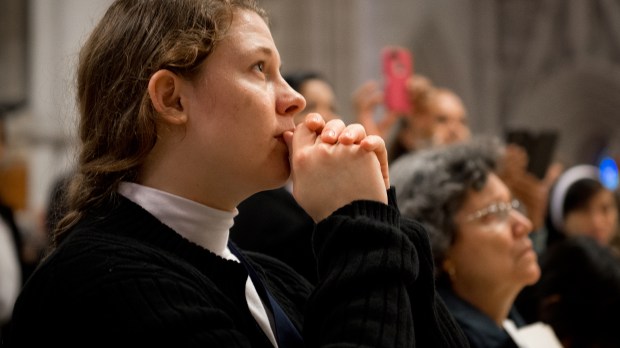The world doesn’t realize it — could perhaps hardly imagine it — but earlier this month consecrated virgins from every continent, from a wide variety of life circumstances and ranging in age from their late 20s to past 80 were gathered in Rome to help celebrate the closing of the Year of Consecrated Life.
This international meeting, titled “Consecrated Life in Unity,” was sponsored by the Congregation for Institutes of Consecrated Life and Societies of Apostolic Life (the Vatican office that oversees consecrated life in all its various expressions). It brought together representatives from the variety of forms of consecrated life in the Church today, including cloistered monastic life; apostolic religious life and societies of apostolic life; secular institutes; newly developing forms of consecrated life and the Ordo Virginum, of which I am a member.
The Ordo Virginum (or “Order of Virgins”) does not refer to an “order” in the sense of a specific religious order like the Order of St. Benedict (Benedictines) or the Order of Preachers (Dominicans) but is rather a more ancient usage of the term which describes a certain type of person or vocation within the Church. While consecrated virgins are members of the Ordo Virginum in the sense that they fall into this ordo as a category, a consecrated virgin enters into consecrated life as an individual, and remains under the direct authority of her bishop.
In a sense, consecrated virginity is both the oldest and the newest form of consecrated life in the Church today. Since apostolic times, there have always been some Christian women who felt called to dedicate themselves to Christ as completely as possible by renouncing the possibility of an earthly marriage and committing to live a life of perpetual virginity. Centuries before women were able to profess vows as nuns in established religious communities, the Church had already established a ritual for solemnly consecrating women to a life of virginity.
With the rise of organized monastic life in the early Middle Ages, the Rite of Consecration to a Life of Virginity gradually came to be reserved to only certain types of cloistered nuns. However, the Vatican II document Sacrosanctum Concilium called for a revision of the Rite of Consecration, and in 1970, this renewed version of the ritual was promulgated. While most elements of the traditional Rite were maintained, one notable update was that the Rite was now explicitly extended — and actually, now seemed to be primarily intended for — non-cloistered women, or “women living in the world.” And so, in a situation somewhat parallel to the reintroduction of permanent deacons, the revised Rite reestablished the ancient Order of Virgins into the life of the modern Church.
Speaking from my lived experience as a consecrated virgin, the unique historical situation of the Ordo Virginum is both a source of strength and inspiration, as well as the cause of many practical problems.
On the one hand, consecrated virgins have inherited a rich spirituality from the venerable text of the Rite itself as well as from the writings of the Church Fathers. For example, because they offer themselves to the Lord in a particularly whole-hearted way, a consecrated virgin was traditionally given the title “bride of Christ,” which prompted the Fathers of the Church to describe consecrated virgins as being a special image of the Church herself.
One the other hand, since the Rite of Consecration to a Life of Virginity was only renewed in 1970, there are still many open questions as to how this vocation is to be lived out concretely. An instance where this is especially evident is the lack of specific details in the Church’s universal law regarding the discernment of vocations to consecrated virginity or the formation of aspiring consecrated virgins. And, due to the relative obscurity of this vocation over the past few decades, consecrated virgins can tend to be somewhat isolated from each other, which can make it difficult to give and receive sisterly spiritual support.
In the face of these challenges, I am sure I am not the only consecrated virgin who found the Vatican symposium to be wonderfully encouraging. While the talks at our meeting were certainly insightful and helpful, in some ways the real benefit of attending the symposium was simply the opportunity to encounter other consecrated virgins from around the world. It was inspiring to hear about the many remarkable ways consecrated virgins are involved in serving the Church — we heard from consecrated virgins serving as professional theologians, consecrated virgins who administer great charitable projects, consecrated virgins involved in various forms of missionary activity, and even from a consecrated virgin involved in historic art preservation within her diocese.
Even beyond this, it was incredibly heartening to see first-hand how this vocation was growing, even in parts of the world where the Church is facing either religious persecution or the challenges of an increasingly secular society. We ended the conference with the hope that perhaps the year 2020, the year which would see the 50th anniversary of the renewed Rite of Consecration, might be the occasion for another gathering of the Ordo Virginum in Rome.
Jenna M. Cooperis a consecrated virgin of the Archdiocese of New York. She completed a licentiate in canon law at the Pontifical University of the Holy Cross in 2014.

